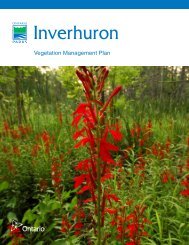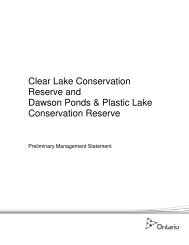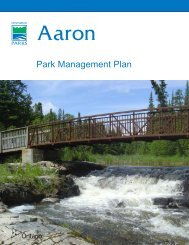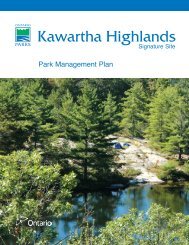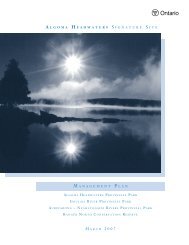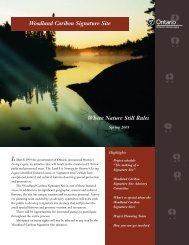Vegetation Plan - Ontario Parks
Vegetation Plan - Ontario Parks
Vegetation Plan - Ontario Parks
You also want an ePaper? Increase the reach of your titles
YUMPU automatically turns print PDFs into web optimized ePapers that Google loves.
Beach and Foredune Management / Maintenance Techniques<br />
Brush, sand fencing and American Beachgrass planting can be used on the beach and foredune to mitigate the<br />
effects of sand migration on facilities where deemed necessary. These management techniques should be kept<br />
to a minimum and caution should be exercised when using these management prescriptions in Pitcher’s Thistle<br />
habitat as there is potential for adverse effects on the species (see Appendix 4: Use of Sand Fencing and<br />
Appendix 5: American Beachgrass <strong>Plan</strong>ting). The advice of the Pitcher’s Thistle – Lake Huron Dune Grassland<br />
Recovery Team will be sought prior to management actions that may impact Pitchers Thistle. Management<br />
prescriptions that may adversely affect Pitcher’s Thistle resulting in dune stabilization or burial will also be<br />
monitored accordingly (See Section 7.0). Sand fencing is the least permanent of the management prescriptions,<br />
allowing for modifications to be made as necessary (Peach 2005).<br />
4.2.2 <strong>Vegetation</strong> Management Unit B: Treed Sand Dunes<br />
<strong>Vegetation</strong> management unit B includes all areas within vegetation communities SBTD1-2 (Balsam Poplar Treed<br />
Sand Dune), SBTD1-20 (White Cedar-Balsam Fire Treed Sand Dune), SBOB1-3 (sand barrens) and CUM1-1<br />
(cultural meadows) plus the southern two polygons defined as SWMM1-1 (cedar swamps). This area takes in<br />
the north-east corner of the park, extending south past the main interior park access road to the eastern park<br />
border. It encompasses portions of the parks historical and development zones (Figure 4).<br />
The objectives of management prescriptions in vegetation management unit B are to preserve the forested<br />
dunes in a manner that protects significant archaeological and historical features, allow for the continued<br />
persistence of Pitcher’s Thistle and promote the re-establishment of native species in conifer plantations by<br />
pursuing the following targets:<br />
• Protect cultural and historical values by stabilizing shoreline and backshore sand dunes where<br />
necessary (OMNR 2000);<br />
• Protect SAR values by allowing open areas to maintain themselves;<br />
• Naturalize the area by removing Scots Pine and planting native species;<br />
• Map Scots Pine plantations within the park.<br />
Scots Pine <strong>Plan</strong>tations<br />
Over time non-native conifers such as Scots Pine and Austrian Pine in this vegetation management unit should<br />
be removed. The park management plan states that stabilization of shoreline and backshore dunes is a priority<br />
(OMNR 2001). As such, the removal of large areas of Scots Pine should be carefully considered and a<br />
precautionary approach taken to reduce concerns with erosion and mobilization of sand.<br />
Scots Pine seed can remain viable in the sand for many years (OMNR 2005 a ) and seedlings have aggressive<br />
root systems that can compete with native vegetation (Burns and Honkala 1990). Because of the seed source<br />
established in the sand at Inverhuron and in-seeding of Scots Pine from outside the park boundary, there will<br />
likely be a need for long-term management of regeneration. The Scots Pine plantations should be managed by:<br />
• Controlling seedling regeneration by clipping seedlings off at ground level (OMNR 2005 a );<br />
• Under-planting with native species (Eastern White Cedar);<br />
• Gradually thinning Scots Pine (cutting and chemical girdling) allowing native species in the understory,<br />
such as Eastern White Cedar, Balsam Poplar and Balsam Fir, to become established (OMNR 2005 a ).<br />
Small openings in the canopy can aid in speeding up the process of natural succession and allow for native<br />
species to become established (OMNR 2005 a ). Thinning of Scots Pine should be considered only in large well<br />
treed stands with good ground cover. Areas that are determined appropriate for thinning should be assessed for:<br />
• The size of the area to be thinned and threat of erosion and blowouts;<br />
• Composition and density of native understory growth (OMNR 2005 a ).<br />
14





